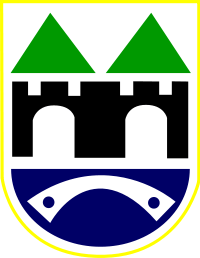Sarajevo in ancient times
| History of Sarajevo |
|---|
|
Ancient times Middle Ages (7th–15th centuries) Early Ottoman era (15th–17th centuries) Late Ottoman era (17th–19th centuries) Sarajevo in Austria-Hungary (1878–1918) Yugoslav era (1918–1992) Modern and post-war (1992–present) |
| See also |
| Timeline of Sarajevo |
The present day site of Sarajevo has a long and rich history dating back to the Stone Age. There were no people in the region in the Paleolithic era, although the remains of ancient animals have been found, such as those of the ancient bear species, Ursus spelaeus. Excavation for the period has never been very comprehensive however, and if the Sarajevo area was indeed inhabited during the Paleolithic era, the residents were probably Neanderthals.
During the neolithic era, the Sarajevo region was home to the Butmir Culture. Specifically, these people found themselves in Butmir, a satellite neighborhood of Ilidža, Sarajevo's chief suburb. The area is rich in flint, essential for making tools and weapons, and was no doubt attractive to ancient man, as was the Željeznica river which flowed by.
The Butmir culture is most famous for their ceramics. Unique and artistic, it is one of the chief reasons why today the Butmir people are identified as a unique culture. The finds were so sensational when they were made in the late 19th century, that the International Congress of Archeologists and Anthropologists was held in Sarajevo the following year. Today, all excavated material can be found in the National Museum of Bosnia and Herzegovina.
The Butmir Culture disappeared around 2400 BC, probably conquered by the next prominent inhabitants of Sarajevo; the Illyrians. The ancient people that considered most of the West Balkans as their homeland had several key settlements in the region, mostly around the river Miljacka and Sarajevo valley. The most prominent of these was Debelo Brdo (Literally "Fat Hill") in today’s Old Town, where there was an Illyrian fortification during the latter Iron Age. Numerous Illyrian forts also existed in other parts of the city, as well as at the base of Trebević mountain.
The Illyrians in the Sarajevo region belonged to the tribe Daesitates, a war-like bunch who were the last to resist Roman occupation. Their last revolt occurred in 9 AD, and was crushed by the emperor Tiberius, marking the start of Roman rule in the region.
During Roman rule, Sarajevo was part of the province of Dalmatia. A major Roman road ran through the Miljacka river valley connecting the rich coastal cities of Dalmatia and the Adriatic coast, with Pannonia to the North. The importance of the road can be seen by the numerous Roman artifacts found in the heart of Sarajevo itself over the years. On the left bank of the Miljacka there were once found Roman bricks and an inscription indicating a construction yard and, nearby, a bathhouse. The biggest known settlement in the region however was known as ‘’Aquae S...’’ (Probably Aquae Sulphurae) on top of present-day Ilidža.
